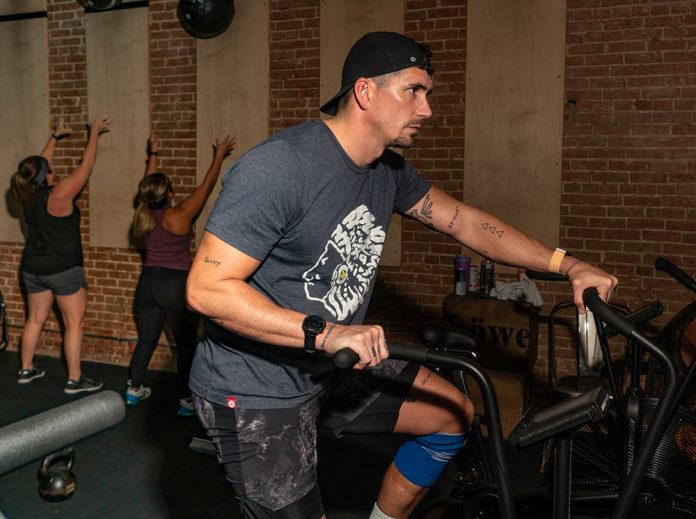There was a time when exercise was how humans survived. Early men and women (and kids) needed to run, lift, carry, throw, balance, jump, and, in general, maneuver their bodies to survive predators. Not to mention walk miles and miles every day to hunt or forage for food.
Oh, the good ole days. Today, we just have to click a few screens and food is delivered to our doors, sans the saber-toothed tiger. Does that mean we can relax and chill since we don’t hunt and forage? Hardly. Now we have cardiovascular disease, diabetes, certain cancers and a host of other conditions to fear if we don’t move enough.
Exercise can help us feel better physically and mentally, improve our mood and help us live longer (not to mention look better). That’s right, let that sink in. We can add extra years to our lives by moving our bodies at the gym, on the road, in the water, on the slopes, on the court, on the yoga mat and, well … you get the idea. It stands to reason that there may not be a better health investment we can make than exercise.
Doctor Camron E. Nelson is president and CEO of Cooper Clinic in Dallas. He says regular exercise is an essential factor in maintaining good health and quality of life. “This is something we’ve known for decades,” he says. “In fact, in a landmark study published in 1989 based on patient data from Cooper Clinic, we learned that moderate exercise dramatically decreases your risk of dying prematurely,” says Dr. Nelson.
Even though it’s been scientifically proven that exercise can help extend our lives, that doesn’t mean it’s easy to fit it into our already busy schedules. Work, school, kids, activities and tons of other daily life chores can easily take precedence over a workout if you let it. How do we stay on track? “One of the biggest reasons people drop an exercise program is lack of interest or that it’s too inconvenient,” says Dr. Troy C. Van Biezen D.C., owner of ChiroSport Specialists of Dallas. In his practice he specializes in sports performance and injury care for professional athletes from the NFL, MLB, PGA, as well as national and Olympic-ranked athletes. “I understand that life gets crazy. We work long hours, raise families, commute, etc. But in the end, we all have the same amount of time – 24 hours. It all boils down to if you want to make fitness a priority in your life,” says Dr. Van Biezen. “If you feel like you don’t have time to go to the gym, add fitness into parts of your routine you already have in your day. You can try running on the treadmill while you watch your favorite show, walk or bike to work instead of driving or find online workout classes to complete at home on your own schedule,” says Joe Bell, fitness director at Cowboys Fit in Frisco. As we age, what we need and expect from exercise changes. Let’s take a look at fitness needs in every decade.
 Endorphins Make You Happy!
Endorphins Make You Happy!
Remember the movie Legally Blonde? There’s a famous quote about exercise from Elle Woods, the film’s protagonist, that sums up why we should exercise. In the movie, young pre-law student Elle discusses a female client’s potential alibi with her pre-law classmates. The client is a fitness instructor accused of murdering her husband. Elle tells a room full of legal colleagues: “Exercise gives you endorphins. Endorphins make you happy. Happy people just don’t kill their husbands; they just don’t.”
While Hollywood tends to over-dramatize with comedic flair, Elle was right. Exercise does improve your mood. Some psychologists call it the ‘mood-enhancement effect.’ Even just a short walk outside can help boost the production of stress-fighting endorphins, part of a group of hormones the body naturally manufactures to help regulate mood.
How does this work? Physical activity and exercise increase levels of serotonin in the brain. In our body part of a group of hormones known as the happy or feel-good hormones, serotonin and endorphins, affect our mood. Serotonin helps promote a feeling of wellbeing and happiness. Endorphins give that ‘runner’s high’ feeling after a workout, followed by the feeling of relaxation.
In studies surrounding depression and exercise, it’s been shown that both low-and-high-intensity physical activities are effective at reducing the likelihood of depression. There’s yet another benefit to starting an exercise routine early in life and never letting go. Scientists believe that people who exercise as young adults have an increased ability to focus and control emotions later in life.
Dr. Van Biezen explains that exercise has been long prescribed to improve mental health. “It can boost your mood, reduce anxiety and depression. Exercise reduces tension in your muscles, increases blood flow, promotes brain activity, releases endorphins (feel-good hormones) and reduces the stress hormone cortisol. In fact,” he says, “a Harvard study states that running for 15 minutes a day or walking for an hour reduces the risk of depression by 20 percent.”
Dr. Nelson also says regular exercise has also been shown to control hormones that contribute to stress and poor sleep. “We all become happier, more productive family members and co-workers when we invest a bit of our timein consistent exercise.”
Teens and 20’s
In your late teens into mid-twenties, you are at your peak physical age. Regular exercise will help keep your heart and lungs in good condition and is very important for managing stress, anxiety and depression. While depression can happen at any age, symptoms very often start in your teens and 20s. “Being in your 20s is a perfect time to build a foundation of fitness. Make it part of your life. This will make it easier to keep it up as you get older,” says Dr. Van Biezen. “I strongly recommend strength training three days a week in conjunction with cardio twice a week. Change it up a bit so you don’t get bored. Hike, bike, or play sports such as soccer or tennis.”
20’s and 30’s
As we age, we lose muscle. Your body also burns fewer calories for the same physical exercise as you did when you were younger. And, as if that isn’t enough, all this makes it harder to keep the pounds from creeping upon us. Stamina and bone densities are at their peak in your 30s so now is a great time to lay the foundation of a long-term fitness routine.
Bell recommends a combination of cardiovascular workouts and resistance training. “Find a trainer, a gym and a culture that promotes different types of fitness. Have an open mind and try as many types of training styles and modalities as you can. You never know what works best for you until you try.”
Heather Mitchell Lancaster, 38, a property manager and mom of four children says exercising helps her stay on track. “Working out at 6:00a.m. each morning sets the tone for my entire day. Starting early allows me to prioritize my fitness needs before the rest of my family wakes up. Because I invest the time early in the day, it helps me stay focused on my goals throughout the rest of the day, keeping me from being derailed by poor food or drink choices that I may encounter.” She works out three times weekly with HIIT (high-intensity interval training) classes. On alternate days, she walks her two energetic Labrador retrievers.
30’s and 40’s
Our 40s are considered the official start of middle age, so regular exercise becomes critical for maintaining good health. Include balance and flexibility training to help preserve lean muscle and keep weight gain minimal. This will also help with reducing the risk of cardiovascular disease and diabetes. “If weight loss is your goal,
you may need to get as much as 300 minutes of moderate-intensity exercise per week. You can also include some vigorous-intensity aerobic exercise such as jogging, elliptical training or spin/cycle activity,” explains Dr. Nelson.
50’s and 60’s
According to Dr. Van Biezen, exercising in your 50s and 60s should include resistance training two to three times a week to keep muscles and bones strong and healthy. He also recommends continuing with a daily aerobic exercise regimen. “I suggest getting outside as much as possible into the fresh air and sunlight. Stretch to help stay loose and limber. Yoga classes are great for this,” says Dr. Van Biezen.
Jill Singletary, 64, is a sales director at a healthcare IT company. She says her lifelong passion and commitment to exercise hasn’t diminished now that’s she in her sixties. Singletary exercises six days a week in group exercise classes, including barre, cardio and strength training and dance classes like Zumba and cardio dance. “Variety is key for me,” says Singletary. “Exercising makes me feel better and gives me an added boost of confidence regarding my appearance. I can have a stressful day at work and go workout. By the end of the class, the tense muscles are gone and the attitude has improved; I can go tackle whatever was bothering me. If for some reason I can’t work out for a couple of days, I start to feel sluggish and I can’t wait to get back to the gym.”
70’s and Beyond
Advancing years can be a time for concern about falling and staying steady on your feet. For women in particular, falling can be even more hazardous if they suffer from osteoporosis or brittle bone disease. “In your 70s and beyond it’s important to maintain your strength and flexibility. Continue your aerobic exercise every week, whether it’s water aerobics, walking or taking dance classes,” Dr. Van Biezen says. “Use resistance bands to keep muscles strong. I recommend incorporating balance exercises such as standing on one foot, leg raises and walking heel to toe.”
Eighty-seven-year-old Joe Barnett is a long time Cooper Clinic patient. “I do a combination of jogging and walking five miles per day, six days a week,” he says. And the benefits he has received from a fitness routine that’s unwavering and steadfast? “The most important benefit I’ve received is that I’m alive.”


